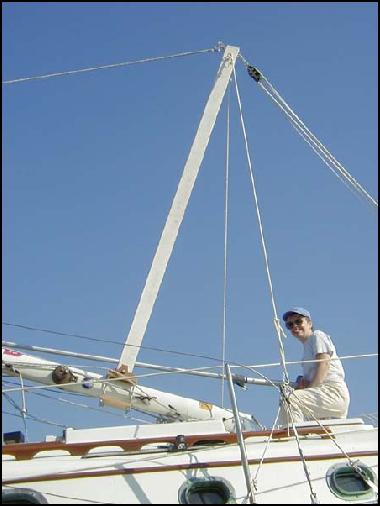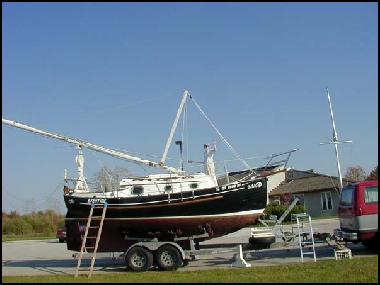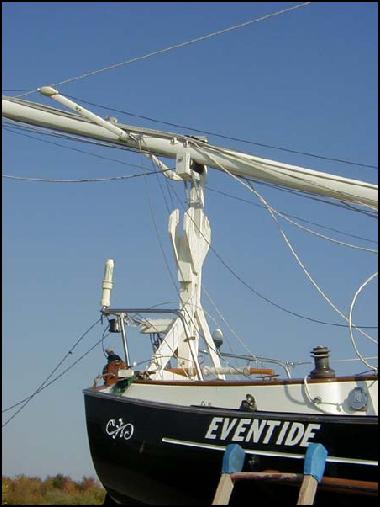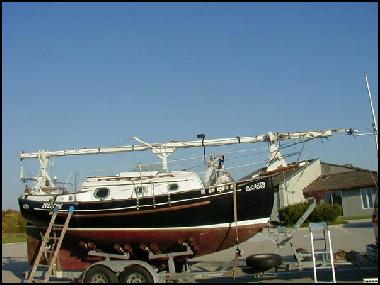Lowering a Flicka Mast by Hand
Mike Nelson

Figure 7. shows the gin pole in place, and the block and tackle rigged. I am shown disconnecting the forestay.
Raising/lowering the mast
We use an adaptation of the mast raising/lowering system described by Bruce Bingham in his Sailor's Sketchbook.
Bingham describes a system for raising and lowering the mast over the bow that uses the boom as a gin pole, combined with a bridle to prevent side sway. The lever arm is shorter if the mast is raised over the stern, however, and the mast is much easier to get into the tabernacle if more of it is on the boat than in space.
We just reversed his system by attaching a gin pole to the front of the mast. We then use a 4-to-1 block and tackle attached to the bow and to the job halyard, and run the line aft to a winch to provide the power. We also attach a crutch to the stern with a roller on it so that the mast does not have to be raised from a totally horizontal position. The roller also helps us move the mast aft so its base will reach the tabernacle. This is definitely a 2-person operation, one person guiding the mast along the crutch, the other guiding the base to the tabernacle.
This method requires removing the forward lower stays and loosening the uppers a bit. Bingham describes how to attach a bridle to each upper stay so that the upper part of the stay remains in tension as the mast is raised or lowered. These bridles prevent side-to-side sway of the mast. A similar bridle is used on the gin pole to prevent it from swaying.
The whole system is pretty stable if all these bridles are used. If it is windy, however, it is a good idea to orient the trailer so that the wind blows along the long axis of the boat. 30 ft of mast attached at the base is quite a lever arm, and is not something to fool around with. Check, double check, and check again every step of the way. One person operates the winch to raise or lower the mast. The other person acts as a lookout for any stays snagging things on the way up or down. In our case, the second person also keeps the roller furling from becoming all messed up.

Figure 8. shows detail of the gin pole and bridle

Figure 9. Shows the mast successfully down, resting in the aft crutch.

Figure 10. Shows detail of the crutch with its roller.

Figure 11. shows the mast removed from the tabernacle and secured for trailering. Note that the mast is supported in the middle, as well as at both ends.
Mike Nelson
S/V Eventide
Photos and Text - © Copyright 1998, 2000, 2001, 2007 Mike Nelson
1. Warnings:
This information is provided in good faith but because launching and retrieving a boat is subject to so many variable, such as the condition of the ramp, the location of the ramp, the boat's trailer, and the operator, as well as other forces, such as acts of God, no warranty is made or implied by the author or the Flicka WebCaptain.
Raising and lowering the mast as described here can be hazardous, and extreme care should be taken to stay out of the path the mast would take if any lines broke or if the wind should cause it to sway out of its intended path. No warranty is made or implied by the author or the Flicka Web Captain about the safety or success of this method.
See additional warnings on the first page of this section.